You’ll need to balance explicit gaze controls for deliberate selections with implicit gaze tracking that reveals cognitive states. Combine gaze targeting with pinch gestures at 40cm distance to reduce fatigue, while implementing 500-600 millisecond error detection for quick corrections. Design adaptive timing thresholds and adjustable sensitivity to accommodate diverse abilities. Use multimodal approaches that separate gaze aiming from hand manipulation, and incorporate real-time cognitive load monitoring to trigger interface simplification when users show erratic scanning patterns. Mastering these principles opens up truly intuitive XR experiences.
Understanding Explicit and Implicit Gaze Interaction Modes
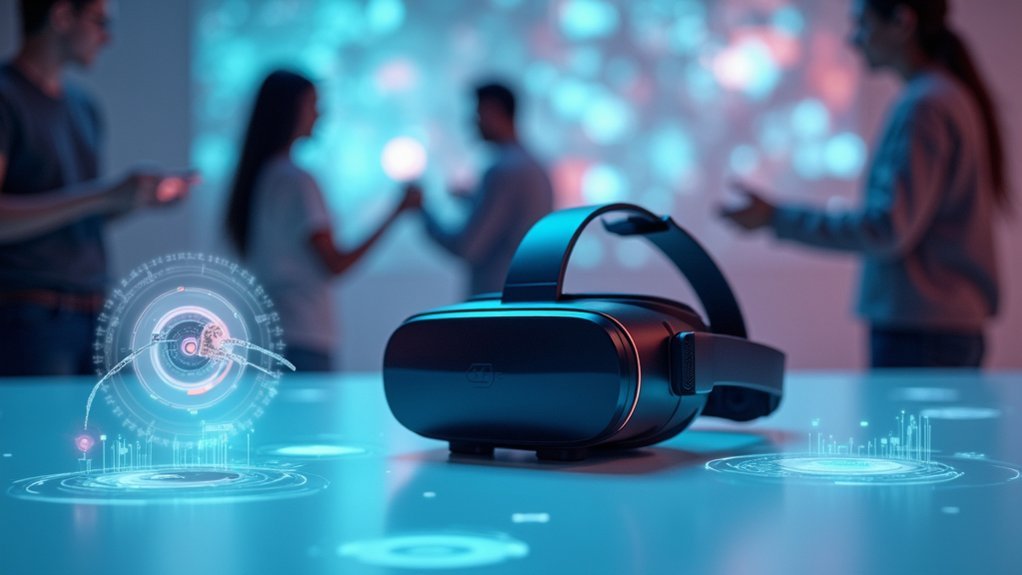
When you interact with XR environments through gaze, you’re engaging with two fundamentally different modes that serve distinct purposes in human-computer interaction.
Explicit gaze requires your controlled eye movements for specific outcomes like selection tasks, offering high bandwidth for pointing and selecting objects. However, you’ll face potential physical fatigue and the Midas Touch problem without careful design consideration.
Implicit gaze captures your natural eye movements, revealing cognitive and emotional states without explicit control. This mode enables systems to provide adaptive response by inferring your intentions and cognitive load, enhancing user experience through personalized content recommendations.
You’ll benefit from rapid error correction within 500-600 ms, reducing cognitive burden. Understanding these distinct interaction modes helps you leverage gaze effectively in XR environments.
Optimizing Gaze and Pinch Integration for Natural Hand Movements
Building upon these interaction modes, the combination of gaze and pinch gestures creates one of the most intuitive multimodal approaches for XR environments. This Gaze + Pinch interaction leverages eye tracking for target selection while hand gestures handle execution, considerably improving user performance through clear task division.
You’ll find this approach reduces cognitive load by allowing your eyes to aim while your hands manipulate objects naturally. Effective design principles emphasize ideal spatial organization, placing interactive elements on a 2D plane roughly 40cm from your position to minimize eye strain.
Success depends on accommodating user attention dynamics during complex tasks. When you’re implementing these systems, consider timing coordination between gaze selection and pinch execution to maintain natural interaction flow without compromising performance in three-dimensional spaces.
Minimizing Cognitive Load Through Multimodal Timing Design
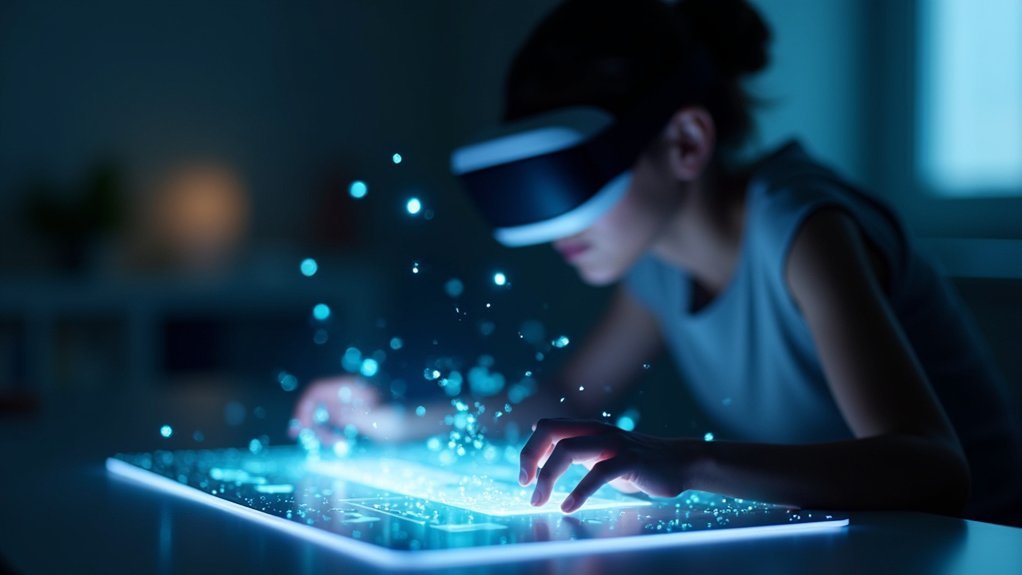
Since cognitive load represents one of the primary barriers to effective XR adoption, strategic timing design becomes essential for creating seamless multimodal interactions. You’ll find that effective multimodal timing design enables seamless switching between gaze-based interactions and hand inputs, greatly reducing mental fatigue. When you implement minimalistic timing mechanisms, you’re facilitating smooth shifts between gaze targeting and gesture confirmation, which enhances user experience considerably.
| Timing Strategy | Cognitive Impact | Implementation |
|---|---|---|
| Adaptive Thresholds | Reduces misclassifications | Context-aware delays |
| Predictive Timing | Minimizes wait states | Gaze dynamics analysis |
| Feedback Synchronization | Enhances intuitive interaction | Real-time responses |
| Dwell Optimization | Improves task completion rates | User-specific calibration |
Leveraging Eye Tracking Precision for Target Selection Accuracy
While traditional hand-pointing methods often suffer from tremor and depth perception challenges, eye-tracking technology transforms target selection in XR environments by harnessing your natural ocular fixation abilities.
When you combine gaze tracking with pinch gesture registration, you’ll achieve remarkably precise target selection that reduces overshooting and missing targets.
This interaction design approach greatly enhances user experience by minimizing cognitive load—systems can detect selection errors within 500-600 milliseconds, allowing immediate correction.
You’ll benefit from high-bandwidth selections, especially when your hands are busy with other tasks.
Key design considerations include aligning interactions with natural eye movement patterns to prevent physical fatigue during extended sessions.
This multimodal approach guarantees your gaze precisely identifies targets while gestures confirm selection.
Building Flexible Gesture Support Systems for Object Manipulation
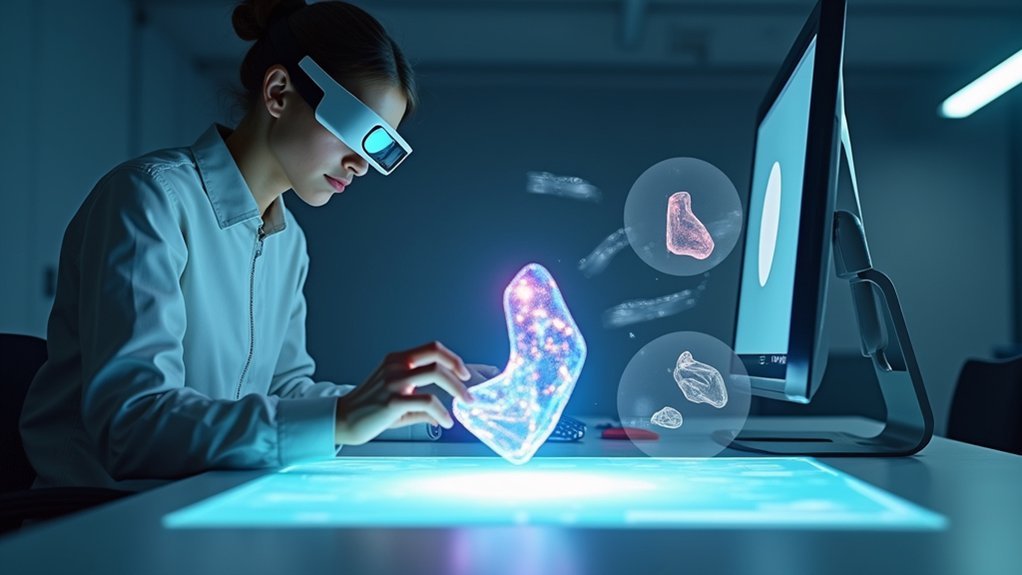
Beyond precise target selection, XR environments demand robust gesture support systems that adapt to your manipulation needs across varying object complexities.
You’ll find that integrating gaze-based interactions with hand gestures creates lightweight control mechanisms, particularly when using pinch interaction to manipulate single or multiple targets simultaneously. Eye-tracking technology enables seamless attention shifts between objects while maintaining control efficiency throughout your tasks.
These gesture support systems must accommodate your natural interaction patterns, allowing effortless switching between different manipulation modes.
You’ll quickly adapt to the dynamics between gaze fixation and hand movements, improving your overall performance. By implementing indirect control mechanisms, you reduce physical effort while maximizing usability.
Effective object manipulation in XR environments requires systems that respond precisely to your combined gaze and gesture inputs, ensuring smooth workflows.
Ensuring Compatibility Between Direct Touch and Gaze-Based Controls
You’ll need to implement time multiplexing strategies that allow users to switch seamlessly between gaze and direct touch controls without losing precision or creating confusion.
Space multiplexing integration becomes essential when you’re designing systems where both interaction methods can coexist in the same virtual environment without interfering with each other.
Creating seamless modality changes requires you to minimize timing delays and maintain consistent object behavior whether users are gazing at targets or directly manipulating them with hand gestures.
Time Multiplexing Strategies
When designing XR interfaces that support both gaze and touch inputs, time multiplexing strategies become essential for creating seamless user experiences.
You’ll want to allow users to switch fluidly between gaze-based interactions for object selection and direct touch inputs for manipulation tasks. This approach minimizes cognitive load by letting users naturally shift between interaction modes without conflicting commands.
Focus on precise timing and synchronization to prevent unintentional inputs during mode shifts. You should implement clear temporal boundaries that distinguish when gaze targeting ends and touch manipulation begins, especially for drag-and-drop actions.
Consider your users’ interaction preferences when designing these changes—some prefer quick switches while others need longer buffer periods. Robust time multiplexing accommodates diverse scenarios in XR environments, ensuring your interface responds appropriately regardless of how users choose to interact.
Space Multiplexing Integration
While time multiplexing handles sequential interactions, space multiplexing integration enables you to use gaze and touch inputs simultaneously across different spatial regions of your XR interface. This approach enhances user experience by allowing seamless shifts between gaze interactions and direct touch inputs without losing context or increasing cognitive load.
You’ll want to design your multimodal interaction systems so users can manipulate virtual objects through either modality depending on spatial convenience. Effective design guidelines suggest creating interfaces that support single-action completion, especially for drag-and-drop tasks where object loss represents a critical failure point.
Your space multiplexing implementation should maintain intuitive interaction flow across XR environments. By accommodating both gaze and hand modalities within distinct spatial zones, you’ll create flexible interfaces that adapt to user preferences while ensuring robust spatial awareness throughout the interaction process.
Seamless Modality Transitions
Because users naturally shift between interaction methods during XR experiences, seamless modality changes become essential for maintaining flow and preventing frustration. Time multiplexing enables you to switch smoothly between gaze targeting and direct touch manipulation without losing context or efficiency. Your interactions remain fluid as the system maintains awareness of your current task state during changes.
Effective seamless changes enhance usability by preserving your workflow momentum. You can begin an action with gaze selection and complete it through pinch gestures, or switch to direct touch when objects move within arm’s reach. This flexibility accommodates your natural movement patterns and preferences.
- Context preservation – Your selection state transfers between modalities without requiring re-targeting
- Coordinated timing – Gaze and gesture confirmations synchronize for accurate user experience
- Lightweight manipulation – Combine gaze precision with hand gesture flexibility
- Single action completion – Minimize effort through streamlined drag & drop workflows
Implementing Error Detection and Adaptive Feedback Mechanisms
You can leverage real-time gaze monitoring to detect user and system errors within 500-600 milliseconds, creating responsive XR environments that adapt instantly to interaction problems.
Your system’s cognitive load assessment capabilities will analyze gaze patterns to understand when users feel overwhelmed or confused, enabling targeted interventions before frustration builds.
Real-Time Gaze Monitoring
As you navigate through XR environments, real-time gaze monitoring systems continuously analyze your eye movements to detect both user errors and system malfunctions within 500-600 milliseconds of occurrence.
These systems enhance interaction efficiency by inferring your intentions and cognitive load, enabling adaptive feedback that reduces mental strain and improves usability.
- Algorithm accuracy guarantees precise classification of intentional movements during explicit control, preventing misinterpretations that could disrupt your experience.
- Gaze metrics analysis provides personalized content recommendations by understanding your attention patterns and visual preferences.
- Cognitive load detection triggers timely assistance when you’re struggling with complex tasks or interface elements.
- Adaptive feedback mechanisms adjust interface complexity and content delivery based on your real-time engagement levels, optimizing overall user experience.
Cognitive Load Assessment
When your eyes reveal patterns of confusion or hesitation, XR systems can detect elevated cognitive load and implement targeted interventions before you become overwhelmed. Gaze metrics provide objective measures of user confidence while tracking your learning progression through implicit gaze interactions that align with natural eye usage patterns.
| Cognitive Load Level | Gaze Pattern | Adaptive Response |
|---|---|---|
| Low | Smooth tracking | Maintain current interface |
| Medium | Increased fixations | Simplify user interface designs |
| High | Erratic scanning | Provide personalized content hints |
| Critical | Prolonged hesitation | Activate error detection protocols |
These systems enhance user interactions by responding to your cognitive state within 500-600ms, enabling rapid adaptive feedback that reduces unnecessary mental effort and creates more intuitive experiences tailored to your individual needs.
Adaptive Response Systems
Building on these cognitive load insights, adaptive response systems translate gaze-based detection into immediate corrective actions that preserve your flow state.
These adaptive systems leverage gaze metrics to infer user intentions and respond within 500-600 milliseconds of error detection. Real-time gaze dynamics enable personalized content recommendations while error detection mechanisms automatically adjust interface elements based on your cognitive load.
Adaptive user interfaces preload relevant content and optimize interaction efficiency by distinguishing between explicit and implicit gaze patterns.
- Rapid Error Correction: Systems detect and respond to user errors within 500-600ms using gaze behavior analysis
- Intelligent Content Preloading: Adaptive interfaces anticipate your needs by analyzing gaze patterns and context
- Cognitive Load Management: Real-time adjustments reduce mental strain while maintaining interaction fluidity
- Personalized Recommendations: XR interactions adapt content delivery based on your individual gaze dynamics and preferences
Designing Accessible Interfaces for Diverse User Abilities and Preferences
While traditional interface design often follows a one-size-fits-all approach, gaze-based interactions in XR demand a fundamentally different strategy that prioritizes adaptability and inclusion.
You’ll need to implement adjustable gaze sensitivity and customizable gesture recognition to accommodate varying physical and cognitive capabilities. Visual cues and haptic feedback enhance comprehension for users with different sensory preferences, while intuitive instructions help those facing cognitive challenges.
Conduct inclusive user testing with participants of diverse abilities to evaluate interaction effectiveness and comfort levels.
Adaptive interfaces powered by machine learning can personalize experiences based on individual gaze patterns and preferences. This accessibility-focused approach guarantees your gaze-based interactions create truly inclusive design that serves users across the entire spectrum of abilities and needs.
Frequently Asked Questions
What Hardware Requirements Are Needed for Implementing Gaze-Based XR Interactions?
You’ll need an XR headset with built-in eye tracking sensors, high-resolution cameras, infrared illuminators, powerful processors for real-time gaze detection, and sufficient RAM for smooth interaction processing and rendering.
How Do Lighting Conditions Affect Eye Tracking Accuracy in XR Environments?
You’ll find that poor lighting greatly reduces eye tracking accuracy. Bright sunlight creates glare, while dim conditions make pupil detection difficult. You should guarantee consistent, moderate lighting and avoid direct light sources hitting your eyes.
What Are the Typical Development Costs for Gaze-Based XR Applications?
You’ll spend $50,000-$300,000 developing gaze-based XR apps, depending on complexity. Basic prototypes cost less, while enterprise solutions with advanced eye tracking, custom UI elements, and extensive testing require notably higher budgets and specialized developer expertise.
Which XR Platforms Currently Support Advanced Gaze Interaction Features?
You’ll find advanced gaze tracking on HoloLens 2, Magic Leap 2, and Varjo headsets. Meta’s Quest Pro includes eye tracking, while Apple Vision Pro offers sophisticated gaze controls for navigation and selection.
How Long Does User Calibration Take for Gaze Tracking Systems?
You’ll typically complete gaze tracking calibration in 30-90 seconds. Most systems require you to look at 5-9 target points while the device maps your eye movements and establishes baseline tracking accuracy.
In Summary
You’ll create more intuitive XR experiences by carefully balancing explicit and implicit gaze modes while integrating natural hand gestures. Don’t overlook timing optimization and multimodal feedback—they’re essential for reducing cognitive strain. You should prioritize precision in target selection and guarantee your gesture systems remain flexible yet reliable. Remember that accessibility isn’t optional; you must design for diverse abilities from the start. When you implement robust error detection and adaptive feedback, you’ll build interfaces that truly respond to user needs.

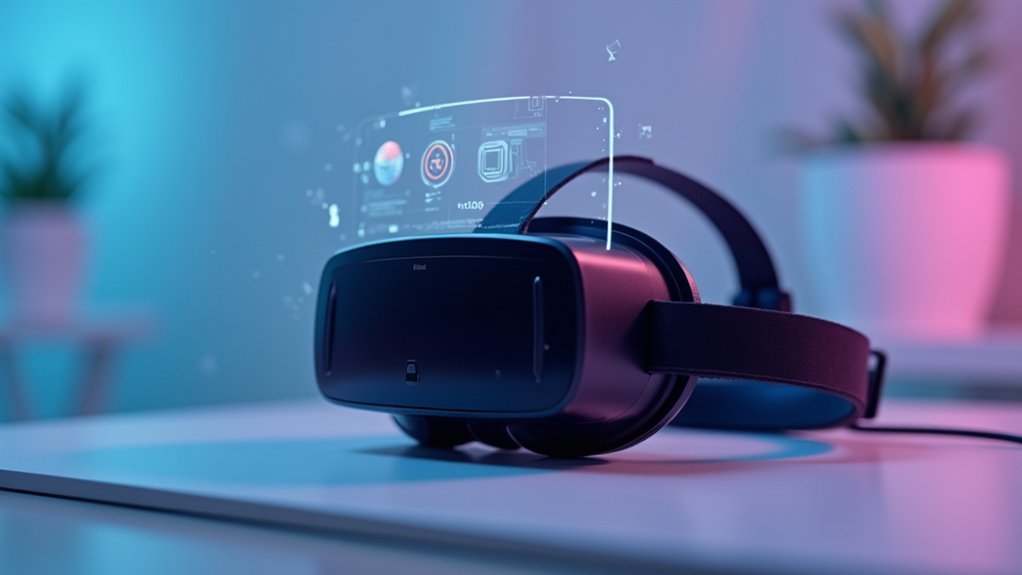


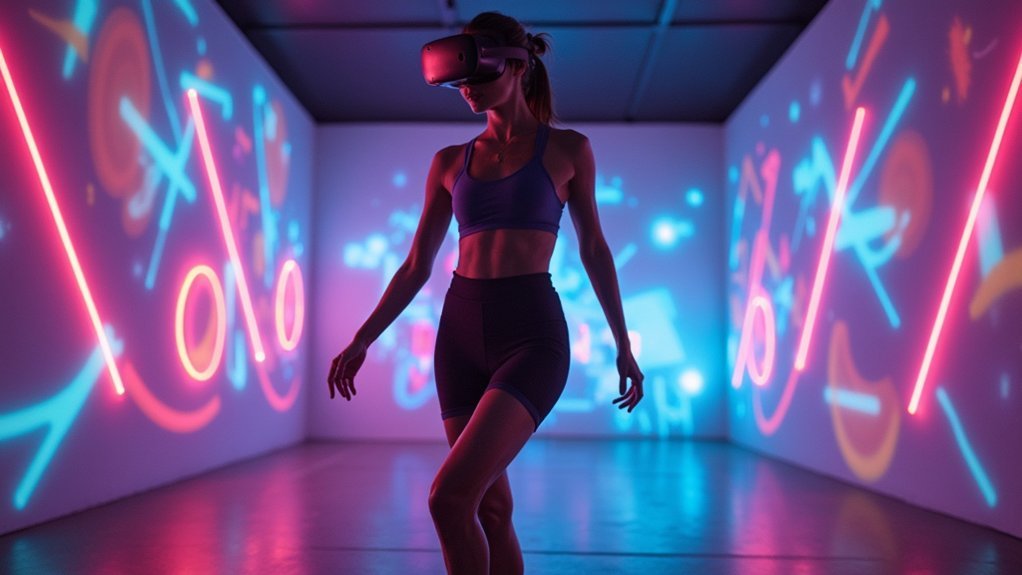
Leave a Reply